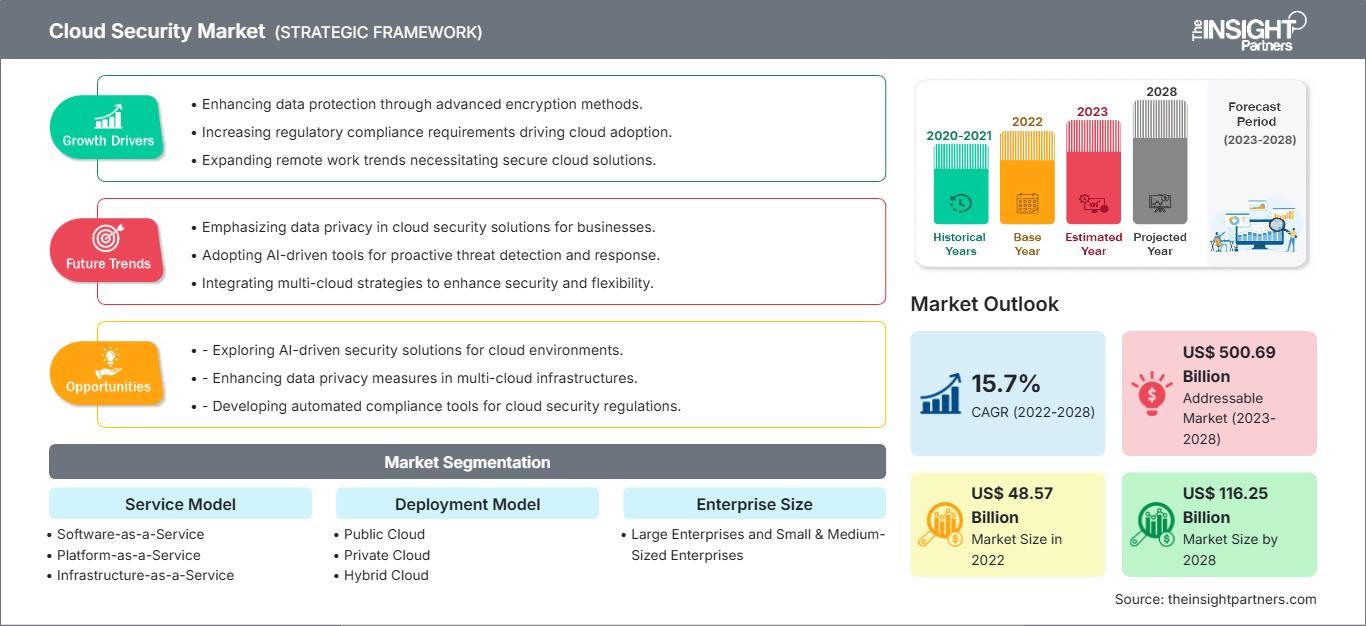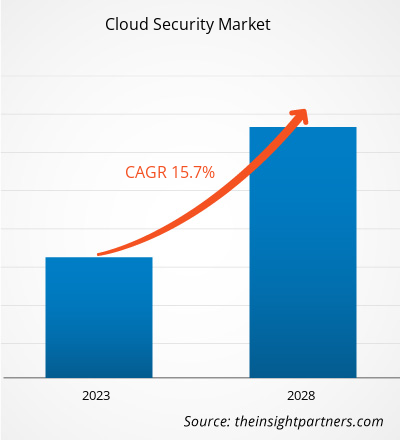Si prevede che il mercato della sicurezza cloud crescerà da 48,57 miliardi di dollari nel 2022 a 116,25 miliardi di dollari entro il 2028; si stima una crescita a un CAGR del 15,7% dal 2022 al 2028.
La sicurezza è diventata fondamentale nelle aziende a causa del crescente numero di violazioni online e attacchi tecnologici. La sicurezza cloud offre numerosi livelli di protezione all'interno dell'infrastruttura di rete contro accessi non autorizzati, violazioni dei dati e attacchi DDoS (Distributed Denial-of-Service). Nel 2022, Flexera, un'azienda americana di software, ha condotto uno studio e ha stimato che quasi il 57% delle organizzazioni sta spostando i propri carichi di lavoro sul cloud. Inoltre, quasi 6 aziende su 10 hanno spostato il proprio lavoro sul cloud. Pertanto, il crescente numero di aziende che utilizzano infrastrutture basate su cloud sta promuovendo l'adozione di soluzioni di sicurezza cloud.
La presenza di grandi aziende note e finanziariamente solide nel settore globale della sicurezza cloud include Amazon Web Services, Inc.; Microsoft; IBM Corporation; Oracle; e Google, Inc.. Per questo motivo, il potere contrattuale degli acquirenti nel mercato della sicurezza cloud è piuttosto elevato. Inoltre, grazie ai progressi tecnologici nella sicurezza cloud e all'aumento dei servizi di container gestiti, si stima che il potere contrattuale degli acquirenti rimarrà elevato nel periodo 2019-2028. Le principali aziende nel mercato della sicurezza cloud utilizzano strategie diverse nella pianificazione di soluzioni e modelli di servizio per diversi settori verticali. Si prevede che i continui progressi nel settore tecnologico metteranno sotto pressione i fornitori di sicurezza cloud, che dovranno adattarsi ai cambiamenti per mantenere la propria posizione di mercato.
Personalizza questo rapporto in base alle tue esigenze
Potrai personalizzare gratuitamente qualsiasi rapporto, comprese parti di questo rapporto, o analisi a livello di paese, pacchetto dati Excel, oltre a usufruire di grandi offerte e sconti per start-up e università
Mercato della sicurezza cloud: Approfondimenti strategici

- Ottieni le principali tendenze chiave del mercato di questo rapporto.Questo campione GRATUITO includerà l'analisi dei dati, che vanno dalle tendenze di mercato alle stime e alle previsioni.
Potrai personalizzare gratuitamente qualsiasi rapporto, comprese parti di questo rapporto, o analisi a livello di paese, pacchetto dati Excel, oltre a usufruire di grandi offerte e sconti per start-up e università
Mercato della sicurezza cloud: Approfondimenti strategici

- Ottieni le principali tendenze chiave del mercato di questo rapporto.Questo campione GRATUITO includerà l'analisi dei dati, che vanno dalle tendenze di mercato alle stime e alle previsioni.
Impatto della pandemia di COVID-19 sulla quota di mercato della sicurezza cloud
L'epidemia di COVID-19 ha avuto un impatto drammatico sull'economia globale durante il suo picco nel 2020, ostacolando le attività commerciali in diversi settori in tutto il mondo. Ha inoltre interrotto le operazioni di diverse aziende, clienti e partner per un periodo di tempo indefinito a causa di restrizioni di viaggio e chiusure aziendali. Il modello di lavoro da remoto e ibrido è cresciuto rapidamente grazie agli enormi investimenti nella trasformazione digitale. Inoltre, si è verificata un'adozione massiccia della sicurezza cloud, alimentata dalla pandemia, dall'espansione dei data center, dalla spesa pubblica per grandi città intelligenti e dai progetti della pubblica amministrazione a supporto dell'adozione aziendale di tecnologie emergenti. Il settore del software non è stato colpito dalla pandemia, poiché diverse aziende hanno consentito ai propri dipendenti di lavorare da casa. Inoltre, le aziende hanno adottato sempre più soluzioni e servizi di sicurezza cloud per ridurre il fabbisogno di manodopera per la manutenzione dei dati. Ciò ha permesso loro di proteggere la forza lavoro da possibili infezioni, garantendo al contempo che la produzione non venisse ostacolata.
Approfondimenti di mercato - Mercato della sicurezza cloud
L'aumento dell'utilizzo di soluzioni basate su cloud e servizi di sicurezza gestiti alimenta la crescita del mercato della sicurezza cloud
La domanda di servizi basati su cloud è aumentata significativamente durante la pandemia di COVID-19 a causa dell'adozione diffusa del modello di lavoro da casa. Microsoft ha registrato un picco del 775% nella domanda per la sua piattaforma di servizi cloud nel 2021. Le piccole e medie imprese (PMI) stanno adottando servizi di sicurezza gestiti poiché non dispongono delle competenze interne per gestire efficacemente i servizi cloud. Secondo OTAVA, queste strategie consentono loro di combinare i vantaggi di un cloud pubblico con la sicurezza di un ambiente cloud privato on-premise. Secondo il rapporto "State of the Cloud" 2020 di Flexera, le aziende stanno adottando i servizi cloud, con il 93% di esse che utilizza una strategia multi-cloud e l'87% che preferisce una strategia cloud ibrida. Si registra una notevole domanda di servizi di sicurezza cloud offerti da importanti fornitori di sicurezza informatica come Google, Microsoft e Amazon. Alcuni potenziali vantaggi dell'integrazione del cloud computing nelle procedure e nelle operazioni delle PMI sono l'accesso semplificato, la rapida implementazione, i bassi requisiti di infrastruttura IT e i bassi costi di installazione.
Approfondimenti basati sul modello di implementazione
In base al modello di implementazione, il mercato della sicurezza cloud è segmentato in cloud pubblico, privato e ibrido. Nel 2022, il segmento del cloud pubblico ha rappresentato la quota di mercato maggiore per la sicurezza cloud. Le aziende stanno implementando ampiamente il cloud pubblico tramite provider di servizi cloud (CSP) di terze parti per gestire applicazioni e dati all'interno della propria infrastruttura. Inoltre, i principali attori del mercato continuano a fornire strumenti di sicurezza integrati, che contribuiscono a proteggere i dati aziendali critici. Il pubblico in generale, i singoli individui e le aziende sono ampiamente attratti dalle infrastrutture di cloud pubblico in quanto offrono scalabilità dei servizi e semplificano il carico di lavoro di gestione per il personale IT interno. Questi fattori stanno guidando la crescita del mercato della sicurezza cloud nel segmento del cloud pubblico.
Gli operatori che operano nel mercato della sicurezza cloud si concentrano principalmente sullo sviluppo di prodotti avanzati ed efficienti.
- Nell'agosto 2022, VMware Inc ha introdotto miglioramenti significativi alle sue esclusive funzionalità di sicurezza laterale per aiutare i clienti a raggiungere la sicurezza per applicazioni moderne e tradizionali per ambienti multi-cloud, stimolando così la crescita del mercato della sicurezza cloud.
- Nel giugno 2022, Palo Alto Networks ha ampliato la piattaforma di protezione delle applicazioni cloud-native con funzionalità come l'analisi della composizione del software basata sul contesto e la distinta base del software.
Approfondimenti regionali sul mercato della sicurezza cloud
Le tendenze e i fattori regionali che influenzano il mercato della sicurezza cloud durante il periodo di previsione sono stati ampiamente spiegati dagli analisti di The Insight Partners. Questa sezione analizza anche i segmenti e la geografia del mercato della sicurezza cloud in Nord America, Europa, Asia-Pacifico, Medio Oriente e Africa, America meridionale e centrale.
Ambito del rapporto sul mercato della sicurezza cloud
| Attributo del rapporto | Dettagli |
|---|---|
| Dimensioni del mercato in 2022 | US$ 48.57 Billion |
| Dimensioni del mercato per 2028 | US$ 116.25 Billion |
| CAGR globale (2022 - 2028) | 15.7% |
| Dati storici | 2020-2021 |
| Periodo di previsione | 2023-2028 |
| Segmenti coperti |
By Modello di servizio
|
| Regioni e paesi coperti | Nord America
|
| Leader di mercato e profili aziendali chiave |
|
Densità degli operatori del mercato della sicurezza cloud: comprendere il suo impatto sulle dinamiche aziendali
Il mercato della sicurezza cloud è in rapida crescita, trainato dalla crescente domanda degli utenti finali, dovuta a fattori quali l'evoluzione delle preferenze dei consumatori, i progressi tecnologici e una maggiore consapevolezza dei vantaggi del prodotto. Con l'aumento della domanda, le aziende stanno ampliando la propria offerta, innovando per soddisfare le esigenze dei consumatori e sfruttando le tendenze emergenti, alimentando ulteriormente la crescita del mercato.

- Ottieni il Mercato della sicurezza cloud Panoramica dei principali attori chiave
Il mercato della sicurezza cloud è segmentato in cinque regioni principali: Nord America, Europa, Asia Pacifico (APAC), Medio Oriente e Africa e Sud America. Nel 2022, il Nord America ha guidato il mercato con una quota di fatturato sostanziale, seguito dall'Europa. Inoltre, si prevede che l'Asia Pacifico registrerà il CAGR più elevato del mercato dal 2022 al 2028.
Amazon Web Services, Inc.; Microsoft; IBM Corporation; Oracle; Trend Micro Incorporated; VMware, Inc.; Palo Alto Networks, Inc.; Cisco Systems, Inc.; Check Point Software Technologies Ltd.; e Google, Inc. sono tra i principali attori che operano nel mercato della sicurezza cloud. Il rapporto di mercato fornisce approfondimenti dettagliati sul mercato, che aiutano i principali attori a definire strategie di crescita nei prossimi anni.
- Analisi storica (2 anni), anno base, previsione (7 anni) con CAGR
- Analisi PEST e SWOT
- Valore/volume delle dimensioni del mercato - Globale, Regionale, Nazionale
- Industria e panorama competitivo
- Set di dati Excel
Report recenti
Rapporti correlati
Testimonianze
Motivo dell'acquisto
- Processo decisionale informato
- Comprensione delle dinamiche di mercato
- Analisi competitiva
- Analisi dei clienti
- Previsioni di mercato
- Mitigazione del rischio
- Pianificazione strategica
- Giustificazione degli investimenti
- Identificazione dei mercati emergenti
- Miglioramento delle strategie di marketing
- Aumento dell'efficienza operativa
- Allineamento alle tendenze normative




















 Ottieni un campione gratuito per - Mercato della sicurezza cloud
Ottieni un campione gratuito per - Mercato della sicurezza cloud